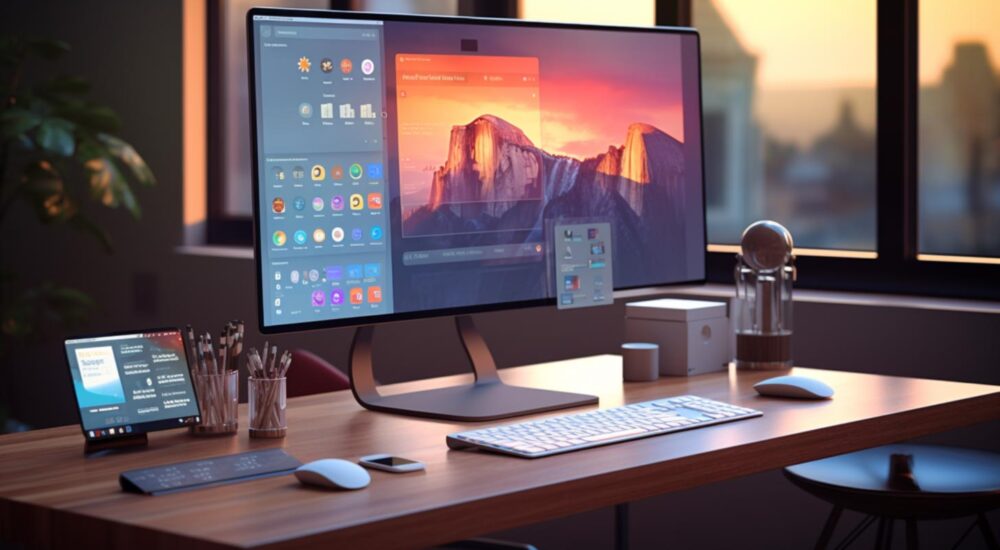Let's have a chat about taking your digital marketing to the next level
Where two combatants choose to fight is sometimes as important as the skills and experience possessed by the two warriors. In the online world user experience plays a pivotal role in shaping our online journeys. A better user experience can get more conversions, leads, sales, and turn one-time purchases into repeating customers. Those with a poor user experience…well, they lose.
As shoppers use their mobile devices or a desktop computer, the battle for providing the best user experience is ever-present. Retailers that have the best user experience for both their mobile and their desktop users will win the fight.
But to win a battle one must prepare for it. Understanding the nuances of user experience for both modes is critical. To face the task of giving your users the optimum user experience, you need to know what the strengths and weaknesses of both platforms are.
And that’s what I plan to talk about right now. Without further adieu let’s dive into the world of mobile and desktop user experience and gain a better understanding of how you should plan your site’s user experience.
Understanding User Experience
As I’ve mentioned in earlier blogs, the concept of user experience encompasses the overall satisfaction and enjoyment that users derive from interacting with a website or application. User experience encompasses a broad range of factors, such as ease of use, accessibility, aesthetics, and functionality. By creating an optimal user experience, a business can enhance customer satisfaction, boost engagement, and drive conversions. More sales = more revenue = a happier business owner, right?
Defining user experience even further: it is the outcome of a user’s interactions with a product, system, or service. UX encompasses their perceptions, emotions, and responses throughout the entire user journey. It’s important to note that user experience is not solely determined by the visual aspects of a design, but also by factors such as usability, performance, and content relevance. Each of these ingredients contribute to the totality of the UX.
When it comes to usability, a user-friendly interface plays a crucial role in ensuring a positive user experience. This includes intuitive navigation, clear and concise instructions, and well-organized content. Additionally, performance is another key aspect of user experience. A fast-loading website or application can significantly impact user satisfaction and engagement. Users expect quick response times and seamless interactions, and any delays or glitches can lead to frustration and abandonment.
Content relevance is also a vital component of user experience. Users visit websites or use applications with specific goals in mind. If the content does not meet their expectations or provide value, they are likely to leave. Therefore, businesses must understand their target audience and create content that is informative, engaging, and tailored to their needs.

Importance of User Experience
Now that we understand the concepts behind UX, we turn to why it’s still vitally important for a business’ website.
A positive user experience fosters trust, encourages repeat visits, and ultimately leads to higher conversion rates – all goals that the vast majority of website owners desire. When users have a pleasant experience, they are more likely to engage with the website or application, explore its offerings, and make a purchase or take the desired action. They are even more likely to leave reviews, offer testimonials, or share a link to their circle of friends and family.
A poor user experience can have detrimental effects on a business. If users encounter difficulties in navigating a website or find it hard to understand how to use an application, they are likely to become frustrated and abandon their interaction. They will find a competitor website that offers a better UX and spend their dollars there. Poor UX design increases bounce rates and decreases the chances of converting potential customers into paying ones. If your website has a high bounce rate (75% or more), you may be suffering right now from bad UX.
Taking things a step further, user experience directly impacts a brand’s reputation. As I just mentioned, having positive experiences lead to positive word-of-mouth, which can attract new users and expand the customer base. Conversely, negative experiences can result in negative reviews and damage the brand’s image, potentially leading to a loss of customers and revenue. It can be hard to quantify how greatly a bad UX can contribute to negative reviews online, but it can have a chilling long-term effect for a business depending on their online reputation.
This is why the site owner or marketing manager needs to investing in their site’s user experience for long-term success. Businesses need to continuously evaluate and improve their websites and applications to ensure they meet user expectations and provide a seamless and enjoyable experience. By doing so, they can differentiate themselves from competitors, build customer loyalty, and drive business growth.

The Difference Between Mobile and Desktop Platforms
As technology advances and standard sizes of mobile phones and desktop monitors evolve, the experiences for these two user groups adapt. What was in fashion (and affordable) five years ago is outdated today. User preferences change and adapt too as influencing factors shape user desires and perceptions.
Consider the rise of Netflix and streaming platforms. How many people are now watching movies and TV shows on mobile devices versus the size of that audience five years ago, pre-pandemic?
The Surge in Mobile Technology and UX
No one can doubt that mobile devices have revolutionized the way we access information and engage with the digital world. The convenience of on-the-go connectivity, coupled with the vast array of apps and mobile-optimized websites, has made mobile devices an integral part of our daily lives. Affordable bandwidth plans allow people to watch and access online content with ease.
From mobile banking apps that allow us to manage our finances with a few taps to ride-sharing apps that have transformed the way we travel, the impact of mobile technology is far-reaching.
Think about the rise of touch interfaces and gesture-based interactions; people now expect their mobile UX to be more interactive than their desktop UX. Intuitive and immersive are buzzwords frequently used by mobile UX designers, and for good reason. From swiping and pinching to zooming and tapping, these gestures have become second nature to us, allowing for seamless navigation and interaction with our devices.
Anyone managing a website that overlooks the differences between a mobile UX and a desktop UX does so at their own peril.

Don’t Discount the Desktop UX
Despite the surge in more mobile technology, desktop computers remain a constant in many professional and creative environments. The larger screens, full-sized keyboards, and advanced processing power make desktops indispensable for tasks that demand precision and multitasking.
As an example, desktops continue to be the preferred choice for professionals in fields such as graphic design, video editing, and software development. The expansive screen real estate allows for detailed work, while the powerful processors ensure smooth and efficient performance.
Furthermore, the presence of familiar operating systems and software on desktops provides a sense of continuity and ease of use for many users. The ability to seamlessly transition from one task to another, with multiple windows and applications open simultaneously, is a feature that mobile devices have yet to fully replicate.
Desktops also offer a level of customization and upgradability that is unmatched by their mobile counterparts. From adding more RAM to upgrading graphics cards, the desktop user experience provides users with the flexibility to tailor their machines to their specific needs.
Comparing Mobile and Desktop User Experience
Now that we see the clear differences in desktop and mobile user experiences, we can start building a plan to deliver the best experience for both groups.
What we now know is that:
- mobile platforms typically feature simplified layouts and navigation menus to accommodate smaller screens
- mobile UX focuses more on touch interactions and swipe gestures, allowing users to navigate through apps and websites with ease
- on the other hand, desktop interfaces can utilize more complex designs, featuring multiple windows, menus, and keyboard shortcuts
- desktops have larger screen size allows for greater flexibility in displaying information and enhancing productivity
- desktop users can have multiple applications open simultaneously, making it easier to multitask and switch between tasks effortlessly
Accessibility and usability are crucial aspects of any user experience, ensuring that individuals with disabilities have equal access to digital content. In the past ten years mobile devices have made significant strides in improving accessibility with their built-in assistive technologies such as voice assistants and screen readers. These features enable users with visual impairments or motor disabilities to interact with their devices effectively, and may make the mobile UX preferrable to those individuals.
However, desktop UX still offer a wider range of accessibility options, such as specialized peripherals and software, catering to different needs and preferences. For example, individuals with hearing impairments can benefit from desktop applications that support closed captioning or visual alerts.

The Impact of Screen Size on User Experience
Screen size is also a key differentiating factor between mobile and desktop platforms and has a profound impact on the overall user experience.
-
Mobile Screens: Advantages and Limitations
The compact size of mobile screens offers the advantage of portability, allowing users to access information and perform tasks while on the move. However, the limited screen real estate poses challenges in terms of displaying content and interface elements. Designers must carefully optimize layouts and prioritize content hierarchy to ensure optimal usability and readability.
-
Desktop Screens: Benefits and Drawbacks
Desktop screens provide a larger canvas for designers to craft expansive and immersive experiences. The increased space offers more room for detailed visuals, complex interactions, and multitasking. However, the larger screen size also necessitates careful consideration in terms of content organization and responsive design, especially when dealing with users who use smaller or multiple monitors.
-
The Role of Apps and Websites in User Experience
Both mobile apps and websites have their unique roles in shaping the user experience.
-
Mobile Apps and User Experience
Mobile apps provide a dedicated and personalized experience, tailored specifically to the device’s capabilities. By leveraging device features such as GPS, camera, and push notifications, apps offer enhanced functionality and convenience. They also allow for offline access, ensuring uninterrupted usage, even in areas with limited connectivity.
-
Websites on Desktop and User Experience
Websites, particularly those optimized for desktop screens, offer a broader reach and accessibility across different devices. Websites provide the flexibility of cross-platform compatibility, allowing users to access information seamlessly, regardless of the device they are using. Additionally, website updates and enhancements can be implemented without requiring users to download and install updates, ensuring a frictionless experience.
What We’ve Learned
In conclusion, the battle for user experience supremacy between mobile and desktop platforms rages on. There isn’t a clear victor, and unless a new way to interact with technology comes about, both UXs offer pros and cons for their users.
By better understanding the intricacies of user experience, any business that’s looking for online customers can adapt and optimize their designs to provide exceptional experiences across all devices. Ultimately, the key lies in striking the right balance between functionality, accessibility, and aesthetics to deliver a superior user experience, regardless of the platform chosen.
Spend the time to refine and improve both your mobile and desktop user experiences. The results will scale your opportunities, as you see them, for your business.

